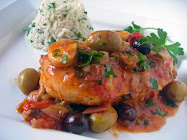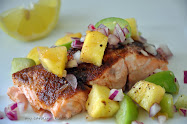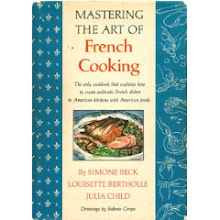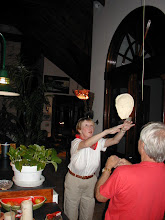As I flipped through my latest cookbook, Williams-Sonoma’s New Flavors for Appetizers, I saw a recipe for salmon cakes. I said to myself as I looked at the beautiful photograph, these look just like crab cakes except they’re pink inside.
They are a perfect alternative to pricy lump crab cakes. Made with cooked salmon, they are a snap to put together. We served them for light dinner on a bed of baby lettuce mix, but their original purpose, as you can guess by the name of the cookbook, was for appetizers.
Believe me, these cakes in no way resemble your mother’s salmon croquettes from your childhood that she made with canned salmon and deep fried. I gently pan sautéed them in a few tablespoons of grapeseed oil. Although grapeseed oil is expensive, it doesn’t contain any transfats and has a neutral taste which doesn’t interfere with or overpower the delicate flavor of seafood. It’s also nice because it can be heated to a high temperature without burning. Feel free to substitute another transfat-free neutral tasting oil, such as canola or safflower oil, if you wish.
When you make the cakes, don’t be tempted to mix them in the food processor. It will quickly make mush of them. It’s also important that you let the cakes rest in the refrigerator for at least thirty minutes so they become firm, otherwise they fall apart while you’re cooking them. I’ve also included a recipe for our favorite way to cook salmon that turns out perfectly every time.
The simple mayonnaise sauce with zesty wasabi is tempered by the sweet honey and tart lime, giving it an Asian flair. It would also be excellent with crab cakes.
Asian style salmon cakes with wasabi mayonnaise
Adapted from Williams-Sonoma New Flavors for Appetizers
Makes 6 cakes – 3 to 6 servings
½ pound cooked wild salmon, skin removed (see recipe below)
1 tablespoon minced yellow onion
1 cup Panko bread crumbs
Kosher salt and freshly ground black pepper
1 tablespoon good quality mayonnaise or my homemade, link here
All purpose flour
1 egg, beaten to blend with a dash of Tabasco or other hot sauce
Grapeseed oil, or any transfat-free neutral tasting oil
Baby lettuce mix
Wasabi mayonnaise:
1/3 cup good quality mayonnaise, either homemade, link here, or Hellmans
1 teaspoon wasabi paste (the tube variety)
½ teaspoon honey
1 teaspoon freshly squeezed lime juice
Place the cooked salmon in a large bowl and flake with a fork. Add the onion, ½ cup of Panko bread crumbs, a little kosher salt and freshly ground black pepper and about a tablespoon of mayonnaise and mix gently until it comes together. Add more mayonnaise if needed to bind the cakes. Now remember that I don’t recommending using a food processor, because the mixture will turn to mush.
Using your hands form into six equal cakes. Place on a plate, cover and refrigerate for at least 30 minutes for the cakes to become firm. It’s important to chill the cakes or they will fall apart when you sauté them.
In the meantime, whish together the ingredients for the wasabi mayonnaise and store it in the refrigerator until you’re ready to serve the cakes.
When the cakes have chilled sufficiently, remove them from the refrigerator. Place the flour, beaten egg and remaining Panko crumbs in three separate bowls. One at a time dip the cakes in the flour, then the egg mixture and finally the crumbs, shaking off any excess in each step.
Heat two to three tablespoons of grapeseed oil in a 14” non-stick skillet over medium high heat. Carefully add the cakes to the skillet and shallow fry until golden brown on the first side, then turn and brown the other side, taking care not to let them burn. It should take about four to five minutes total cooking time. Remove cakes to a plate.
To serve, arrange a handful of baby lettuce on each plate and top with a crab cake. Dribble each cake with some of the wasabi mayonnaise and serve right away.
Cook's notes: If you find you need more mayonnaise to bind the ingredients together as one reader suggested, please add accordingly. Also be sure to refrigerate the cakes prior to cooking to help them stay together when you sauté them.
Simple Broiled Salmon
Serves 2
Wild salmon fillet, ¾ pound, preferable with the skin left intact
1 tablespoon grapeseed oil, or any transfat-free neutral tasting oil
Kosher salt & freshly ground black pepper
A few crushed pink peppercorns give it a nice twist (optional)
A squeeze of fresh lime juice
Put salmon in a dish; rub with oil, salt & pepper generously and let sit at room temperature for ten to fifteen minutes. Preheat the broiler.
Arrange fish, skin side down, on an unheated sheet pan lined with heavy duty foil for easy clean-up. Place the fish under the broiler about three inches from the source of heat. Broil 8 to 10 minutes or just until it is cooked through. It’s not necessary to turn the fish. If it starts to get too crispy on the top, change from broil to bake and bake at 400 degrees until done. Take care not to overcook or it will dry out. Remove from the oven and carefully remove the skin with a sharp knife. Squeeze with a little fresh lime juice. If not serving right away, let it cool and refrigerate, covered. It can be kept for a day or two in the refrigerator in a covered container.









































